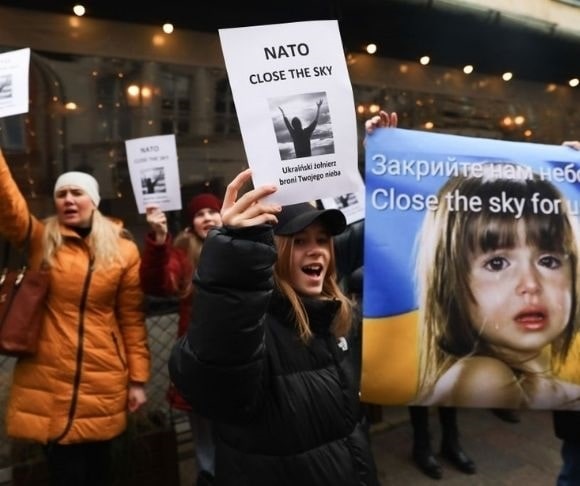President Volodymyr Zelensky is pleading for a “no-fly zone” over Ukraine. The desperation in his supplication is difficult to ignore. Arguably, when Russian bombers and cruise missiles are killing dozens of your fellow citizens by the hour, dispassion is not easily embraced. Advocates for and against a NATO- or US-imposed aerial cordon sanitaire over Ukraine have been insistent and vocal. But what would such an effort entail? It is not as simple as flying fighters from neighboring NATO countries to prevent Russian bombers from attacking Ukraine’s ground forces.
 Clearing the sky of Russian aircraft requires shooters, fighters, support aircraft, and command control planes like NATO Airborne Warning and Control Systems or AWACS. Several AWACS aircraft would have to be airborne continuously to achieve 24-hour coverage. So, a sizable air armada is necessary to achieve an effective no-fly zone over Ukraine. After all, Ukraine is roughly the size of Texas. Moreover, the AWACS capability would direct fighters to intercept the enemy, allowing for more efficient use of NATO air assets versus numerous fighter jets setting up orbits, waiting for the Russians to show up.
Clearing the sky of Russian aircraft requires shooters, fighters, support aircraft, and command control planes like NATO Airborne Warning and Control Systems or AWACS. Several AWACS aircraft would have to be airborne continuously to achieve 24-hour coverage. So, a sizable air armada is necessary to achieve an effective no-fly zone over Ukraine. After all, Ukraine is roughly the size of Texas. Moreover, the AWACS capability would direct fighters to intercept the enemy, allowing for more efficient use of NATO air assets versus numerous fighter jets setting up orbits, waiting for the Russians to show up.
The United States has established no-fly zones before to prevent adversary access to the skies over specific geographic areas. During operations Northern and Southern Watch, US Air Force and Navy aircraft, and aircraft from the UK and France, kept the skies over Iraq in the north and south free of Saddam Hussein’s air force in the 1990s. No-fly zones also were established in the skies over Bosnia and Libya. In these cases, the United States and its allies enjoyed complete air supremacy. That does not exist in Ukraine.
Nevertheless, the United States and its European allies have significant airpower, and the temptation is enticing to use that capability in support of Ukraine. “A broad bipartisan majority of Americans think the United States should stop buying Russian oil and gas and work with NATO to set up ‘no-fly zones’ to protect Ukraine from Russian airstrikes according to a Reuters/Ipsos poll completed on [March 4],” Reuters reported. Approximately 74% of those polled, both Republicans and Democrats, favored NATO establishing a no-fly zone. Early in the Ukraine conflict, US lawmakers such as Senator Roger Wicker (R-MS) were outspoken in favor of establishing Russian-free skies over Ukraine.
Advocates for a Ukraine no-fly zone include former NATO supreme allied commander Europe and four-star retired US Air Force General Philip Breedlove. But Breedlove tempered his enthusiasm for putting NATO aircraft in harm’s way by suggesting a more limited no-fly zone for humanitarian relief. “The rules of engagement would be that we are constructing a humanitarian operation to allow for humanitarian relief corridors and all other manner of things on the ground below them. We are not going to fire on our opponent unless our opponent fires on us,” Breedlove explained to Fox News. But during the chaos of war among maneuvering aircraft, who fired on whom first is often lost in the melee. The fact is NATO forces would be able to shoot down Russian aircraft. That, by most standards, is an act of war.

Marco Rubio (Photo by Alex Wong/Getty Images)
“A no-fly zone has become a catchphrase. I’m not sure a lot of people fully understand what that means. That means flying AWACS 24 hours a day, that means the willingness to shoot down and engage Russian airplanes in the sky,” Senator Marco Rubio (R-FL) told George Stephanopoulos on ABC News’ This Week.
Additionally, President Joe Biden’s declaration he would not put US troops directly into the Ukraine conflict with Russia applied to US aircraft participating in a no-fly operation. The risk of getting the US into a war with the Kremlin that could escalate into a nuclear attack is just not in the cards for NATO or the United States. “What we’re trying to do is end this war in Ukraine, not start a larger one,” Secretary of State Antony Blinken explained, according to the New York Post.
But does saying “no” to the Ukrainian president’s entreaty to keep Moscow’s bombers out of Ukraine’s airspace foreclose other options? More capable, longer-range PATRIOT anti-aircraft missile systems could be sent to Ukraine with volunteer contractor support for on-the-job training. The United States and NATO could move combat units temporarily to non-NATO partners in Eastern Europe. Supplying military units, particularly anti-aircraft systems, tanks, and armored personnel units, to Georgia and Moldova would send a clear message to Putin. Rejection of the no-fly zone option demands every other alternative short of engaging Russia directly should be employed.
The views expressed are those of the author and not of any other affiliation.
~ Read more from Dave Patterson.




